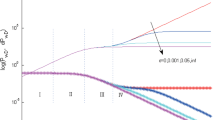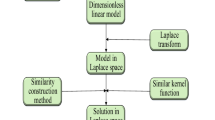Abstract
For the three-region composite reservoir, this paper establishes the nonlinear spherical seepage model of three-region composite fractal reservoir under three kinds of outer boundary conditions (infinite boundary, constant pressure boundary and closed boundary). The seepage model considers wellbore storage, effective radius and quadratic pressure gradient. First, the established seepage model is turned into boundary value problem of composite-modified Bessel equation in Laplace space by canceling out its dimensions and dealing it with Laplace transform. Second, using the similar constructing method to solve the nonlinear spherical seepage model, its analytic solution is obtained. Third, the expression of dimensionless bottom-hole pressure of the model in real space is obtained using the Stehfest numerical inversion equation to the solution in Laplace space. Finally, the corresponding-type curves of three-region composite reservoir with quadratics pressure gradient are mapped by programming. After that, sensitivity analysis of deferent parameters is carried out. Error analysis shows that the effects of quadratics pressure gradient should not be ignored.


















Similar content being viewed by others
Abbreviations
- B :
-
Formation volume factor (dimensionless)
- C :
-
Well-bore storage coefficient (m3/MPa)
- \( p_{\omega } \) :
-
Bottom-hole pressure (MPa)
- q :
-
Production rate (m3/d)
- \( p_{0} \) :
-
Initial reservoir pressure (MPa)
- R :
-
The outer boundary radius (m)
- h :
-
Reservoir thickness (m)
- \( \eta_{i} \) :
-
Pressure transmitting coefficient (µm3 MPa)
- z :
-
Laplace space variable (dimensionless)
- \( C_{{L_{i} }} \) :
-
Fluid compressibility (MPa−1)
- \( r_{\text{we}} \) :
-
Effective wellbore radius (m)
- \( C_{t} \) :
-
Compressibility (MPa−1)
- \( k_{i} \) :
-
Permeability (µm2)
- \( p_{i} \) :
-
Reservoir pressure (MPa)
- r :
-
Well-bore radius (m)
- S :
-
Skin factor (dimensionless)
- \( \mu_{i} \) :
-
Viscosity (MPa s)
- \( \phi_{i} \) :
-
Porosity (dimensionless)
- t :
-
Time (h)
- \( d_{{f_{i} }} \) :
-
Fractal dimension (dimensionless)
- \( \theta_{i} \) :
-
Fractal exponent (dimensionless)
- –:
-
Laplace domain
- D :
-
Dimensionless
- w :
-
Well-bore parameter
References
Acuna JA, Yortsos YC (1995) Application of Fractal Geometry to the Study of Networks of Fractures and Their Pressure Transient. Water Resour Res 31(3):527–540
Acuna JA, Ershaghi I, Yortsos YC (1995) Practical application of fractal pressure transient analysis of naturally fractured reservoirs. SPE Form Eval 10(3):173–179
Al-Zainaldin S, Glover PWJ, Lorinczi P (2016) Synthetic Fractal Modelling of Heterogeneous and Anisotropic Reservoirs for Use in Simulation Studies: implications on Their Hydrocarbon Recovery Prediction. Transp Porous Media 116(1):1–32
Beier RA (1994) Pressure-transient model for a vertically fractured well in a fractal reservoir. SPE Form Eval 9(2):122–128
Braeuning S, Jelmert TA, Sven AV (1998) The effect of the quadratic gradient term on variable-rate well tests. J Petrol Sci Eng 21(2):203–222
Camacho-Velázquez R, Fuentes-Cruz G, Vásquez-Cruz MA (2008) Decline-curve analysis of fractured reservoirs with fractal geometry. SPE Reserv Eval Eng 11(3):606–619
Chaidez-Félix JM, Velasco-Hernández JX (2018) An exploration of pressure dynamics using differential equations defined on a fractal geometry. Comput Appl Math 37(2):1279–1293
Chakrabarty C, Farouq Ali SM, Tortike WS (1993) Analytical solutions for radial pressure distribution including the effects of the quadratic gradient term. Water Resour Res 29(4):1171–1177
Chakrabarty C, Ali SMF, Tortike WS (2010) Analytical solutions for radial pressure distribution including the effects of the quadratic-gradient term. Water Resour Res 29(4):1171–1177
Chang J, Yotsors YC (1990) Pressure transient analysis of fractal reservoir. SPE Form Eval 5(1):31–38
Cossio M (2012) A semi-analytic solution for flow in finite-conductivity vertical fractures using fractal theory. In: Proceeding of the SPE annual technical conference and exhibition, San Antonio, Tex, USA, October 2012
Debnath L (2003) Recent applications of fractional calculus to science and engineering. Int J Math Math Sci 2003(54):3413–3442
Dong XX, Li SC, Gui DD et al (2014) A study on solving the boundary value problem of three-region composite second-order linear homogeneous ODE. Energy Educ Sci Technol Part A Energy Sci Res 32(6):6035–6048
Finjord J (1986) Effects of the quadratic gradient term in the infinite-acting period for two-dimensional reservoir flow. In: SPE 16451
Finjord J, Aadnoy BS (1986) Effects of the nonlinear gradient term in exact analytical solutions of the radial flow equation for oil in a reservoir. In: SPE 15969
Finjord J, Aadony BS (1989) Effects of quadratic gradient term in steady-state and quasi-steady-state solutions for reservoir pressure. SPE Form Eval 4(3):413–417
Flamenco-Lopez F, Camacho-Velazquez R (2003) Determination of fractal parameters of fracture networks using pressure-transient data. SPE Reservoir Eval Eng 6(1):39–47
Gaynor GC, Chang EY, Painter S et al (2000) Application of Lévy random fractal simulation techniques in modelling reservoir mechanisms in the Kuparuk River Field, North Slope, Alaska. SPE Paper 39739. SPE Reserv Eval Eng 3(3):263–271
Hu Y, Min C (2016) Identification and modelling of geochemical reactions occurring within the sandstone reservoir flooded by seawater. Pet Sci Technol 34(17–18):1595–1601
Hu Y, Mackay E (2017) Modelling of geochemical reactions occurring in the Gyda Field under cold-seawater injection on the basis of produced–water-chemistry data and implications for scale management. SPE Prod Oper 32(4):449–468
Hu Y, Mackay E, Vazquez O, Ishkov O (2018) Streamline simulation of barium sulfate precipitation occurring within the reservoir coupled with analyses of observed produced water chemistry data to aid scale management. SPE Prod Oper 33(1):85–101
Leont’ev NE (2013) Description of weakly compressible fluid flows in porous media for a nonlinear seepage law. Fluid Dyn 48(3):402–406
Nie RS, Ding Y (2010) Research on the nonlinear spherical seepage model with quadratic pressure gradient and its seepage characteristics. Nat Sci 2(2):98–105
Odeh AS, Babu DK (1998) Comprising of solutions for the nonlinear and linearized diffusion equations. SPE Reserv Eng 3(4):1202–1206
Park HW, Choe J, Kang JM (2000) Pressure Behavior of Transport in Fractal Porous Media Using a Fractional Calculus Approach. Energy Sources 22(10):881–890
Park HW, Choe J, Kang JM (2001) Generalized Bottom-Hole Pressure with Fractality and Analyses of Three-Dimensional Anisotropic Fractal Reservoirs. Energy Sources 23(7):619–630
Poon D (1995) International meeting of the PetSoc. of. CIMSPE9-534
Raghavan R (2011) Fractional derivatives: application to transient flow. J Petrol Sci Eng 80(1):7–13
Razminia K, Razminia A, Trujilo JJ (2015a) Analysis of radial composite systems based on fractal theory and fractional calculus. Signal Process 107:378–388
Razminia K, Razminia A, Torres DFM (2015b) Pressure responses of a vertically hydraulic fractured well in a reservoir with fractal structure. Appl Math Comput 257:374–380
Razminia K, Razminia A, Baleanu D (2015c) Investigation of the fractional diffusion equation based on generalized integral quadrature technique. Appl Math Model 39(1):86–98
Razminia K, Razminia A, Hashemi A (2016) Fractional-calculus-based formulation of the fractured wells in fractal radial composite reservoirs. Environ Earth Sci 75(22):1436
Stehfest H (1970) Algorithm 368: numerical inversion of Laplace transforms. Commun ACM 13(1):47–49
Wang W, Yuan B, Su Y et al (2017) A composite dual-porosity fractal model for channel-fractured horizontal wells. Eng Appl Comput Fluid Mech 12:1–13
Xu P, Qiu SX, Yu BM, Jiang ZT (2013) Prediction of relative permeability in unsaturated porous media with a fractal approach. Int J Heat Mass Transf 64:829–837
Funding
Project supported by Dynamic simulation of the mechanism of shale gas development and the optimal control of the district pollution, Applied fundamental research (Major frontier projects) of Sichuan Province (16JC0314).
Author information
Authors and Affiliations
Corresponding author
Additional information
Communicated by Jorge X. Velasco.
Rights and permissions
About this article
Cite this article
Dong, Xx., Liu, Zb. & Li, Sc. Similar constructing method for solving nonlinear spherical seepage model with quadratic pressure gradient of three-region composite fractal reservoir. Comp. Appl. Math. 38, 83 (2019). https://doi.org/10.1007/s40314-019-0847-z
Received:
Revised:
Accepted:
Published:
DOI: https://doi.org/10.1007/s40314-019-0847-z
Keywords
- Three-region composite fractal reservoir
- Nonlinear spherical seepage
- Quadratics pressure gradient
- Similar constructing method
- Similar structure of solution




